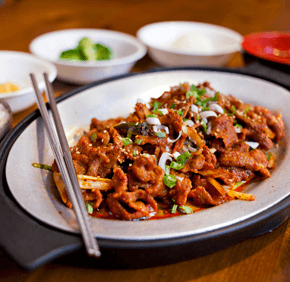By Father Leo Patalinghug
Soul food takes on a whole new meaning (Seoul food) at Thomas and Maria Lee’s Nam Kang Korean Restaurant and Barbecue. It became even more famous when celebrity chef and host of a popular Travel Channel show, Andrew Zimmerman, visited this hot spot for authentic Korean cuisine.
Nam Kang, which the owners described as their “castle,” draws a diverse crowd. The restaurant has a steady flow for lunch and dinner, but gets especially busy between midnight and 4 a.m. Chefs and night clubbers go there after hours, knowing that Nam Kang dishes out remarkable flavors in a pretension-free atmosphere for a great price.
Walking down the stairs to the basement-level restaurant brings you to a modestly decorated eating area. The framed awards, ethnic decor and interspersed religious art make for a humble and homey experience. An upper-level dining area gives barbecue a more sophisticated feel with fitted electric grills, marble tables and large overhead exhausts. It’s perfect for patrons who enjoy the cooking interaction and participation, with the help of the trained staff (of course).
While the menu offers a variety of generic Asian foods, Nam Kang owners rightfully and proudly educate patrons of traditional jjgae, hearty Korean-styled stews; bibimbop, heated rock bowls filled with rice, vegetables and meats of all types; Bindaetteok, a savory pancake with mung beans and scallions; and popular meat courses such as succulent beef bulgogi or sweet and savory kalbi pork.
Korean cuisine typically comes with an assortment of tasty side dishes called banchan – cucumber, radish, cabbage, ginger slices, potato – all meticulously prepared, marinated or pickled.
Novices may be a bit overwhelmed by the contrasting textures, flavors and aromas of the food, in particular the famous pungency of pickled dishes called kimchi, a style of cooking that ferments vegetables (cabbage in particular) to a natural sourness, but also unique deliciousness. It’s a brilliant, sour complement to sweet meats, crunchy rice, soft tofu and savory stews.
Of the many samplings, I was most surprised by the traditional kimchi stew that combined tofu, squid, pork, aromatic vegetables and a few other unknown ingredients. It had a sea aroma of shrimp paste, a broth that tasted earthy – deeply and richly seasoned from the fresh ingredients and finished with lip-
smacking tartness.
Thomas Lee, head chef, surprised me with his special potato salad – a slightly sweet, chilled preparation with onion, cucumber and sugar. It had just enough of an unknown ingredient to make you want taste it again and again to figure it out.
The service felt like a typical experience of ethnic restaurants – friendly, homey and obviously “different.” Thomas and Maria, parishioners of the Cathedral of Mary Our Queen, were gracious, respectful and even holy in their approach to hospitality. Their humility, despite their famous food, is a lesson for all food lovers: approach food and service as if welcoming people into your castle – your home.
This is the kind of place where no-nonsense foodies go to eat. Also, expect leftovers from the generous portions. One regret is that I didn’t find this place when I was younger and out after midnight. I would have sooner discovered a Seoul food from obviously faithful soul foodies.
.jpg)
Also see:


